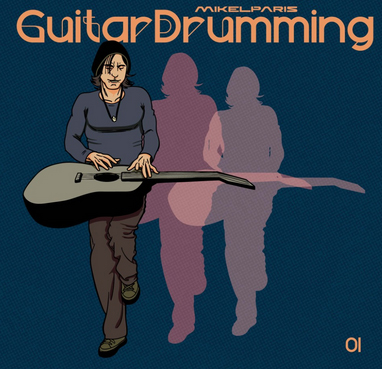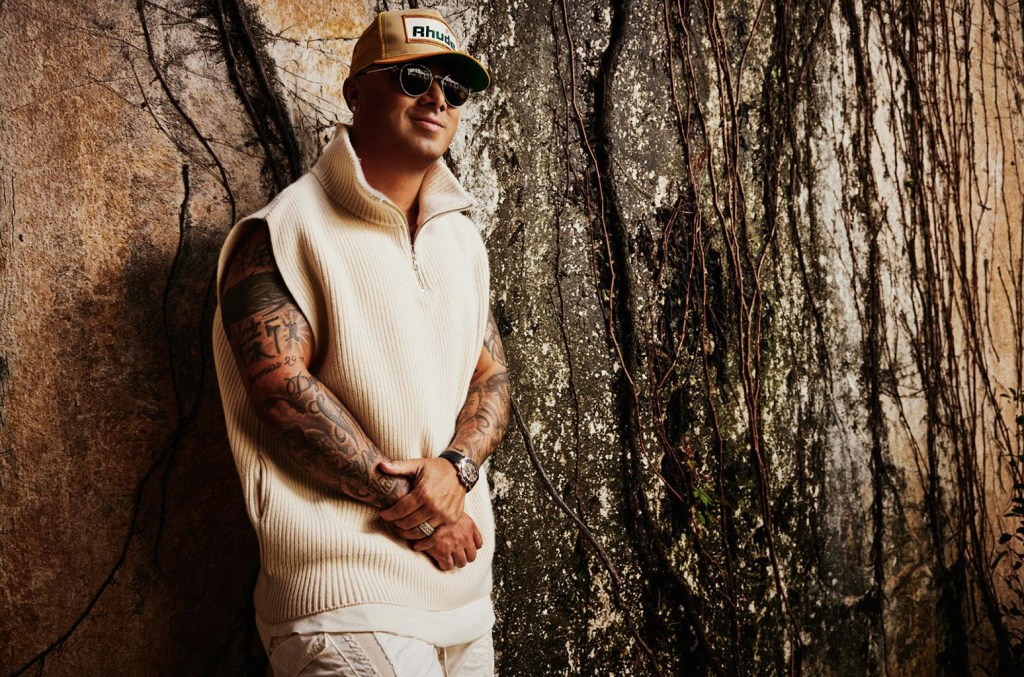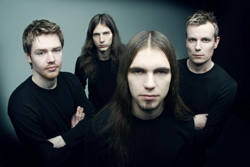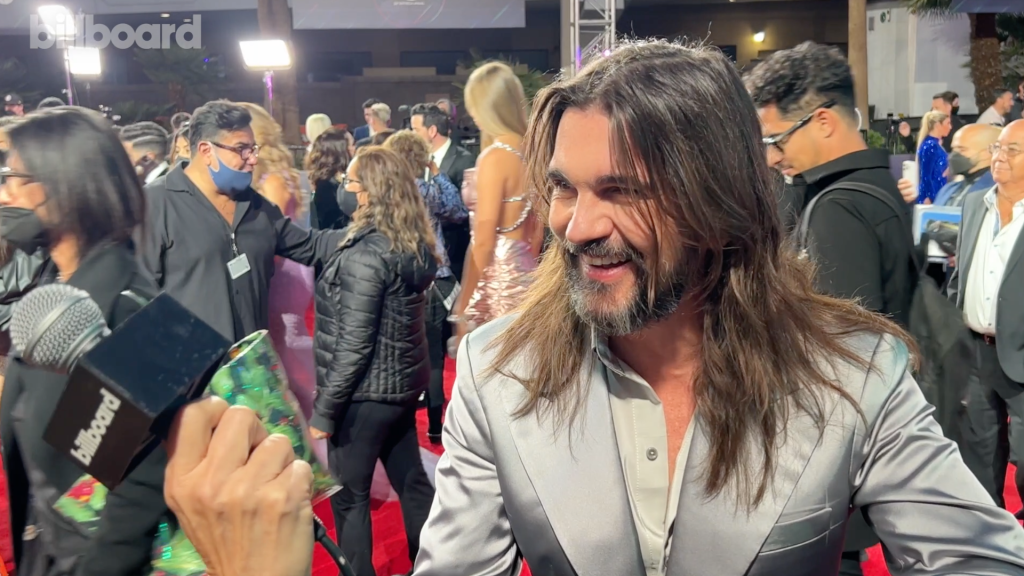MikelParis Talks GuitarDrumming, TuneTrek and O.A.R.

MikelParis is a voracious multitasker. Whether it’s music, short documentaries, livestreams or musical performances, he maintains a full schedule that finds him transitioning from one project to another and then offers them to the world (wide web).
The multifaceted artist has been the keyboardist, percussionist and backup singer for O.A.R. for two decades. Previously, he performed with P!nk, Train, The Dan Band and Jewel. As a filmmaker, he acts as the producer, cameraman, editor and host of TuneTrek, which he films at lesser-known historic places and includes a song written specifically for each location and episode. MP made “Music Drink Stories,” which followed his “A SONG A DAY” series. Started while at home during the COVID shutdown, he worked on new material during livestreams.
Over the summer, he toured with O.A.R. and during any downtime, MP did solo dates in music venues or as part of his home concert, “HouseTrek,” performances. Earlier this year, he put out GuitarDrumming 01, where he focuses on the guitar drumming technique he started to develop as a touring member of the percussive-heavy production, “STOMP.” On the album MP did all the songwriting, lead vocals, keyboards, bass, percussion, stomps, “mouthbone” (vocalized horn parts) and guitar drumming on acoustic guitar.
Joining him on this release are special guests Vernon Reid (Living Colour) on electric guitar on “Good 2 Go,” G. Love on harmonica on “Hitme,” while “Downtime” brings together Of Good Nature’s Cam Brown on vocals, electric guitar and bass and David Hamilton Jr. on drums plus the onetime O.A.R. horn section of Jerry Depizzo, Evan Oberla and Jon Lampley.
Although he’s promoting GuitarDrumming 01, MikelParis is already setting up the GuitarDrumming 02. “I’ve got three albums planned,” he said. “The second one, I’ve already released the first song with good friends of mine, Simplified from Charlotte [North Carolina], “I’m OK. Then, I’ got another one called “Mother” with my friend Stephen Kellogg.”
Recently, a third single came out – “Floweez” featuring Brady Watt.
Although he has much to do throughout the year, Paris is excited to be out on the road with O.A.R. “It’s been awesome to be back on a tour bus. It’s been almost a year since the band’s been able to travel like that…just for logistic reasons.”
Our conversation takes place in the afternoon prior to an O.A.R. show in Clear Lake, Iowa that evening. Afterwards, he planned to visit the “Not Fade Away” exhibit that’s dedicated to the final concert by Buddy Holly, Ritchie Valens and the Big Bopper before their plane crashed in a farm field north of the city.
JPG: Being on tour with O.A.R. is just one part of what you do. You have band shows and solo shows and rarely have time off.
MP: I started releasing music and I realized that I needed to play solo shows to support it, like artists are supposed to do. [Laughs.] Last year was an experiment for me in figuring out a tour within a tour; how to route and book my solo shows within the context of an O.A.R. big summer tour, and it was pretty successful. It was a lot of fun. I’ve incorporated that model for this year as well and got a lot of solo shows coming up that I’m excited about.
JPG: Are those solo shows in venues or HouseTrek events?
MP: A combination of both. I like the HouseTrek formula. It’s been really cool. Then again, I also really like playing in venues where it’s an intimate setting, and I’m gonna reach some people who have never heard me before.
JPG: Are you doing these shows on guitar or keyboards or even looping?
MP: No looping. My solo rig, if I have everything with me, it’s my guitar drumming. I have a stomp platform that I have a kick drum mic in. I have two vocal mics — one clean, one affected, distorted with overdrive and delays that I control on the fly. Then, I’ll have a keyboard off to my right side. So, everything is being created in the moment.
I experimented with looping. I got the gray line 6 JM4 looper pedal and kudos to people that can really do it and who have made it become second nature. For me, it was all about, “What can I do live in the moment? which goes back a little bit to my STOMP days as well. What can we create onstage with the eight of us [in the STOMP cast] with no recordings? That really instilled that ideal in me of I want everything I’m doing up during my solo shows to be…not that looping can’t be organic. I don’t want to say that. But, I want it to be, “How is he making that sound and he’s doing it all at the same time in the moment?” That was my challenge to myself, and the guitar drumming in and of itself covers a lot of bases, no pun intended. It covers that bass texture often, and the percussive and guitar sound. That’s already filling it out a little bit.
Then, adding the stomping as I’m doing it. The stomp platform, I didn’t just arbitrarily do that. It’s a two-by-two wooden platform that my dad and I made. It comes out of my time with the show. That’s my justification for doing it and that has become a large part of my musical vocabulary, that stomp texture, that added thing.
The fact that I can do it while I’m doing everything else is because of all my time — 10 years off-Broadway with that show — it’s ingrained in me.
JPG: Regarding the technical aspects of it. I believe Neil Young, when he was doing a solo acoustic show, had something he was stomping on, and there’s a band called Bonepony that stomped on a board. Do you need to use a particular type of wood to get a sound or use whatever you want?
MP: No. In STOMP they have developed a very specific material, multiple layers of materials, to get that specific sound that the creators wanted of that show with how it’s miked and everything. I wasn’t trying to emulate the exact same tone of the STOMP show and that STOMP stage. I wanted something that wasn’t one of those stomp boxes. They sell them, and I’ve tried them. It seems to work much better when you’re sitting with those. For me, it was about the show STOMP, and where you’re placing your feet from any given moment. It’s always fluctuating a little bit.
So, having a little stomp box that was very specific — four inches by four inches — for me to do that was never going to work and I wanted to have that space. So, now, it’s two by two platform. I put my pedal board on the top of it. So, I have it all figured out.
And it’s not any particular wood. It was just my dad and me. “What does he have lying around the workshop?” It’s eight inches high. We cut a little channel in the front so that I can stick the kick drum microphone in there, and that’s it. It’s got padding on the bottom. It’s solid enough so that me standing on it and stomping on it isn’t gonna crack it.
JPG: I want to get to the origins of the guitar drumming, but, also, I want to bring up STOMP. I’m fascinated by it. I interviewed someone from the current touring production recently, and I remember seeing the show years ago. When did you join STOMP? How long were you there and were you a keyboardist first and saw it as an opportunity?
MP: Yes. Piano was my first instrument. Four-years-old. My mom had the Baldwin upright in the living room and I was listening to her play it. She said that at one point I walked over when she wasn’t playing it, sat down and started messing around with the keys, and she saw that I’d taken an interest. So, she asked if I wanted to take piano lessons. We found a great piano teacher, and it was amazing.
So, piano’s always been my first true love or entrance into the music world other than singing in the tones that babies can make when they’re trying to match pitch with what they hear around them.
I went to school for piano as well. I went to the Hartt School for music. I was trying to be a jazz piano player. Musicians always trying to search “Where’s my niche? What is my journey? How do I navigate this maddening industry?” from one moment to the next. I’m still doing that. [Laughs.]
I remember, I was in New York City, sometime around the 2000s and I saw an ad in the Village Voice, just one of those random things. I moved to New York City originally as an actor. I minored in theater. It was always back and forth between music and theater for me. And I just remember seeing this ad for this show STOMP. It said, “Wear boots.” I thought that was cool. I didn’t really know much about the show at the time.
It was an open call. Multiple callbacks. That whole story of an artist who moves to New York, works in a restaurant or a bar, hustling, auditioning, auditioning, auditioning, trying to find…and everything aligned somehow at that moment. My attitude was right. I didn’t go in there, saying, “Oh my God! I want this! I want this so badly. I need this!” I went in, “This could be fun.” That was my attitude going in, and it turned out that they liked my attitude.
The creators of the show — Luke [Cresswell] and Steve [McNicholas] – and some of the original British cast were there for all the auditions, and I remember Fiona [Wilkes], one of their original performers, saying to me later that she really noticed that I was helping other people with the choreography. It was a little slower process for them to ingest this stuff, and I was getting it kind of quickly, and they really saw that. That was one of the things that put me into, like the A-list, as opposed to the B-list when they were considering.
I traveled all over the world with that show. It was amazing. I have lifelong friends. I was already interested in the rhythm and the music of our environment, of the world around us, and hearing rhythm and music and everything around me. So, these guys, having the confidence to be on the streets of Brighton [England] busking with trash cans, people looking at them side-eyed, sometimes, or like, “What are you doing? That’s just noise. That’s just a racket,” but they knew they were on to something, and they believed in it. That has given me the confidence with the guitar drumming, working my way to that style that I’ve developed and created over the years.
When I got into STOMP, I really thought back to this time just out of college. My first apartment, my friend Todd and I, late night, he had an acoustic guitar and I picked up those devil sticks and I started drumming on the strings as he was doing chords. I thought I created and developed a whole new sound that no one ever heard before, and then I didn’t really think about it.
Then, three or four years later, I get into STOMP and “You know what? I’m going to go back to that.” I had an old, cheap Yamaha acoustic guitar, one of the starter ones. “Let me start experimenting. How can I do this without a partner?” I didn’t even know what it was called yet, but if I was going to do this approach to the acoustic guitar where I lay it flat and I look at it more like a piano, a chromatic…I’m usually DADFAD as far as the string tuning. Then, my thumb is doing a lot of the chord work. Then, this [finger’s] doing a lot of the minor major color tones. This finger reaches around. I just started messing around with this idea again.
I remember I was on tour with STOMP. It was the first tour, and I brought my guitar with me. I was in a hotel room with the cast. We were hanging out. “Yay! We’re touring this amazing show around the country and people are going crazy.” Don’t forget the Orpheum Theater in New York City was like 380 capacity. Then, STOMP goes on tour for the first year to houses that are 2,000, 3000. All of a sudden, as performers, we were hearing this incredible response and energy from these larger crowds, which was absolutely incredible.
So, the guitar drumming evolved during this time. I was in that hotel room, and I was just messing around with the first song that’s on GuitarDrumming 01, “MoveIT.” I wasn’t singing. I was messing around with the groove and the pocket and the feel of it and the mechanics of, “How am I hitting the strings? How am I getting that sound?” And, within, like 30 seconds, the whole hotel room got quiet. I didn’t realize it at first. I looked around and, they used to call me, “Paris,” because there were multiple Michaels. They’re like, “Paris, what are you doing? That’s incredible.” And I was like, “Okay. That’s another little sign that, maybe, I should pursue this. I should see this through to its fruition. I should not make this a gimmick but have it be a way that I write songs; another way that I think about music and composition with this instrument and how I’m playing it with this guitar drumming style. And how does this guitar drumming sound converse with other traditional instruments.”
So, that’s what GuitarDrumming 01 was really a lot about, an experiment in how does my guitar drumming sound work with a drum set? How does it work if there is a bass? How does it work with a harmonica? How does it work with a horn section, tonally and timbre and all of that stuff? It continues to be this experiment for GuitarDrumming 02 as well, looking at instruments to put in place with this style that I’ve developed and created to see how they converse and see what kind of dialogue they have. It’s really been fun and exciting for me.
JPG: You mentioned earlier about being into jazz piano. Was Thelonious Monk an influence because when I hear him, I hear the rhythm of his playing.
MP: All those rhythmic piano players, the jazz players—McCoy Tyner, even Herbie Hancock and Chick Corea—as much as I wasn’t as fast and quick and virtuosic a player as far as modals and patterns, I developed my own way to do fast stuff as a piano player. But for me, it was always about rhythm and people don’t always think about the piano as a rhythm instrument.
It’s funny that you bring up Thelonious because those were the people that I gravitated to when I was in the jazz world; those almost experimentally tonal chromatic players. Philip Glass even, some of his stuff really inspired me. They looked at that instrument very different. Thelonious, we all know, he was his own thing, and his piano was not a piano. It was something else. It was some other instrument. So many of those great piano players, the stories of how they developed and the struggles were definitely very inspirational for me during that period and continue to be.
JPG: How long were you with STOMP?
MP: More or less about 10 years. There were a couple breaks. I played with Pink for about a year-and-a-half, 2001, so I had a break there, which was good. The show is incredibly physical and demanding. It really took its toll on me, and I did not have the greatest core strength during that show. It caused some issues because your posture, often in that show you’re hunched over with brooms and things, and I had some issues. My last couple years with STOMP was…I remember Luke and Steve saying to us, “If you’re ever doing this just for a paycheck, find something else to do.”
I was really starting to struggle physically just to get through a show from those last year-and-a-half to two years, my back, my knee, my heels. Your heels get compressed from doing that show. There was a point where, I think, I had three insoles in my shoes because I was trying to find some way to soften the blow.
I knew that it was time. But, like anything else, especially as performers, we get involved with something that’s a steady paycheck and touring and traveling, you’re going to do what you love to do. The thing I loved about STOMP was that it was musical and it was acting. There was no dialogue but there was non-verbal communication and you had to look at each other onstage and try and create moments between your characters. Everyone has a different character in that show.
So, it was a wonderful 10 years. The idea of the vocabulary of that show is ingrained in my musical structure forever. I do it all the time. You can ask the O.A.R. guys, too. I’m always still doing stuff with the body. (Demonstrates by tapping out a rhythm on his chest) From when I was a kid, my parents told me that I would be in the kitchen trying to entertain people at the table with body and rhythm and vocal percussion, grabbing a pot or a pan, and doing something because I had an idea for a rhythm. I was always doing that.
So, when STOMP came around, it was like, “You guys wrote this show for me!” We all felt that way. So many people in the world feel that way. And what a brilliant show for there to be no language. We traveled all around the world with that. I was in China with it. You didn’t have to speak. All you had to understand was the language of music, and you can say the same about music in general. People from different languages will sing a song in English and know the lyrics, but they don’t know how to speak English.
I can’t say enough how thankful I am for the different journeys and experiences that I’ve had as a performer, as a creative, because all of our journeys are different for every creative, for every performer. I learned early on you make your creative choices in your career based on the things that are presented to you, sometimes, and, sometimes, you go for the things you want. And we don’t know what that journey is going to be.
So, I’ve been very excited and thankful about all these experiences that I’ve had, that have led me to here and led me to this moment where I feel, finally, that I’m ready to get this guitar drumming project out. I’m ready to get this solo stuff out there, and for people to see me as an artist in my own right.
JPG: Your previous solo albums released before Guitar Drumming 01 — Snidbits, HIHOWAREYA VOL. 1 and Flow — had some guitar drumming on them. Correct?
MP: Yes, it’s always been there since I’ve started releasing solo stuff. It’s always been in the texture, but it’s never been the focus.
It’s been multiple decades of getting to that point where I feel like everything is ready. I’ve got this huge catalog of songs where the guitar drumming is the driving force, so why not focus on it?
I’ve got three albums planned. The second one, I’ve already released the first song with good friends of mine, Simplified, from Charlotte [North Carolina], “I’m OK” and another one called “Mother” with my friend Stephen Kellogg.
The album is loosely scheduled for November 2025, GuitarDrumming 02. I’ve got another 20 songs or so on deck for GuitarDrumming 03 to choose from. Then, I’ve got HIHOWAREYA VOL. 2 ready. I’ve got Snidbits and Slippies on the burner, and I’ve got MikelParis TuneTrek. I don’t know if you got to check any of my TuneTrek [YouTube] series. I’m calling it “Season 01.” It’ll be like 14 songs, and then 14 episodes as companion pieces.
I’ve got a lot on the list of things I’m trying to get through in the next two or three years as far as solo releases and projects.
JPG: What I liked about the TuneTrek episodes is that it’s live performance and history.
MP: That project was born out of this idea of, “I’m touring around the country. I’m in a tour bus, staying in hotels, and I’m not going out and having adventures in these cities that I’m in. I’m not exploring and finding new places and new things.” One of the things I love to do, I’ve always been an explorer. I’ve always been behind the woods as a kid in the house, just having adventures, finding a new trail or lifting up a new rock to see what was underneath it. That sense of adventure has always been with me and I realized that I got complacent with it.
This was in 2012, and I was like, “Okay, let me figure something to motivate me to get off the tour bus, to get out of the venue.” My whole day in Iowa not just be on a tour bus in a parking lot. Then, I go out. So, I was, like, “Let me find historic places that are lesser known.”
I’m a big fan of Anthony Bourdain’s Parts Unknown, big fan of Les Stroud (Survivorman), big fan of Daryl Hall’s “Live at Daryl’s House.” Those were the really three big ones for me that I was starting to watch and “What can I take from these to make into a solo adventure that I do with my guitar?”
I write a song for these places, and I interview a person, learn about the history. Lyrically, it was a real fun thing for me because I was able to research the history of this old house or this old factory or this old lighthouse and start getting inspiration for lyrics just from the story of these places. It was a real different way for me to write and create.
Then, people would say to me, “I walked by that house a thousand times. I didn’t know that was the history of that, that there was that story about that or that it was built in 1711. I had no idea it was that old.”
It was real exciting for me to do that, and I’m really excited to get back into that with the album and the release and, maybe, try and get some network. I had about seven episodes run on three different PBS stations as interstitials. They were like 90 seconds to two minutes, and I was really excited about that. I like the short form, but I really wanted to get more into that five to six minutes and do a half hour where I’m at three locations. Once I get back into that “TuneTrek” headspace early next year, that’s part of the team that I’m trying to get together for that project. There’s got to be some place that that can live.
I’ve got 69 episodes, 12 or 13 are up on my website right now that I’ve edited, that have the new theme song and all that stuff.
Pages:Next Page »
Link to the source article – https://jambands.com/features/2025/10/02/mikelparis-talks-guitardrumming-tunetrek-and-o-a-r/
-
CarolBrass smartphone sound amplifier, cell phone sound amplifier, vintage amber finishing. Phone Stand with Sound amplifier, No Plug Phone Speaker for home, Handmade Brass Phone Holder$0,00 Buy product
-
BXIZXD 1.65FT MIDI Cable, 2-Pack 5-Pin Male to Male MIDI Cable for Keyboard Synth, External Sound Card, MIDI Keyboard, Rack Synth, Sampler, Sound Source and Other Music Gear, Black$8,99 Buy product
-
Focal Alpha 50 Evo 5 inch Powered Studio Monitor$299,00 Buy product
-
DigitalLife 2m USB Type C to B MIDI Interface Converter Cable, Compatible with Windows 11 / macOS 14 Sonoma (Metal, Nylon Braided)$9,99 Buy product
-
Ibanez Guitar, Right, Spruce Wood, Spruce Top (PCBE12)$279,99 Buy product
-
Nautical-Mart Brass And Copper Blowing Bugle Horn 10.6″ Inch Signal Musical Instrument Classic Style With Beautiful Colourful Rope Binding$49,00 Buy product











Responses